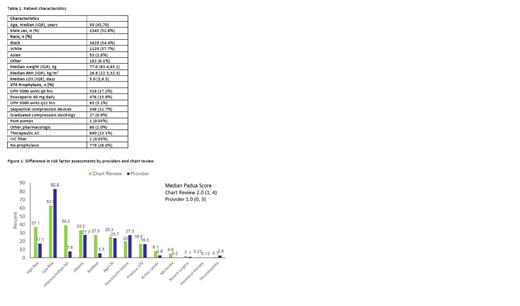Venous thromboembolism (VTE) is a complication of hospitalization but not all patients are at high risk. VTE risk assessment models have been developed to identify patients whose risk is sufficient to warrant pharmacologic thromboprophylaxis. To ensure all patients are risk assessed upon admission, we implemented a mandatory risk assessment tool embedded in admission order sets in our electronic health record (EHR) system. We hypothesized that the accuracy of these risk assessments was variable.
We performed a retrospective cohort study of patients discharged from the Johns Hopkins Hospital medicine service between January 1 st-December 31 st 2019. The cohort consisted of consecutive patients classified into normal, intermediate or low mobility groups using the Johns Hopkins Highest Level of Mobility score. Using a standardized chart review algorithm, elements of the Padua and Improve risk scores were determined using the admission note and the JH-HLM scores for mobility assessment. We report the results of the Padua score comparison. Provider risk assessments, VTE prophylaxis orders, symptomatic VTE, major bleeding (ISTH criteria) and deaths were determined by chart review. We measured concordance between provider risk factors identified and those identified on retrospective chart review. Statistical analyses were done using Chi-squared or Fisher's exact test and were performed using Stata v.18.
The cohort consist of 2992 patients with a median age of 58 (Interquartile range (IQR) 45-70). Characteristics of the cohort are in Table 1. The median provider Padua score was 1 (IQR 0,3) compared with 2 (IQR 1,5) for chart review. Providers identified 2480 patients (82.9%) as being low risk compared with 1882 (62.9%) upon chart review (P<0.001). Differences in risk factor assessments are presented in Figure 1. Concordance rates between providers and chart review were high (93.6%-99.6%) for all risk factors except obesity (87.5%), heart failure (76.4%), reduced mobility (72.5%) and acute infection (66.1%).(Figure 1)
Thirty-six VTE (27 DVT, 9 PE; 1.2%) occurred during the hospital stay and sixty-one (44 DVT;17 PE; 2.2%) within 3 months. Among patients who suffered an in-hospital VTE, providers assessed 29 (80.6%) as low risk compared with 13 (36.1%) by chart review. Fourteen patients (48.3%) were not prescribed prophylaxis. Forty-seven of 61 patients (77.0%) who developed VTE within 3 months were classified as low risk by providers compared with 26 (42.6%) among chart reviewers. Twenty-five (41.0%) were not prescribed prophylaxis. 727 of 2480 (29.3%) patients risk assessed as low risk by providers were assessed as being at high risk upon chart review. 707 of 2480 (28.5%) low risk patients were not prescribed prophylaxis. 157 of these 707 (22.2%) would have been prescribed prophylaxis based upon chart review. Among these 157 patients, 7 VTE occurred during the hospital stay and 11 events occurred within 3 months. Major bleeding occurred during prophylaxis in 4 patients (0.17%).
Underestimation of VTE risk is common in hospitalized medically-ill patients. Development of improved EHR VTE risk assessment tools that assist the provider in identifying patient risk factors could improve VTE prevention and reduce hospital-associated VTE.
Disclosures
Streiff:Pfizer: Consultancy; Bristyol Myers Squibb: Consultancy; CSL Behring: Consultancy.


This feature is available to Subscribers Only
Sign In or Create an Account Close Modal